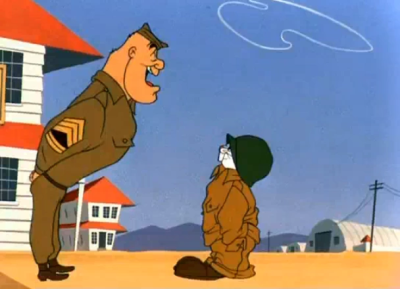The following is a guest post by Erin R. Britt.
During the Golden Age of Hollywood Animation, there was a small, independent studio called Leon Schlesinger Productions that produced cartoon shorts to accompany feature length motion pictures to the cinemas. In 1938, they released a short featuring a rabbit named Happy Hare. Leon Schlesinger Productions would go on to become Warner Bros. Cartoons, the animation division of Warner Bros., and Happy Hare would become one of the most recognizable characters of the twentieth century: Bugs Bunny.
Bugs Bunny’s first credited appearance as a solidified character was in the 1940 Oscar nominated film A Wild Hare by Tex Avery. Bugs turns 80 this year, and he is just as recognizable to people today as he was when he first appeared. Part of that longevity is rooted in his characterization.
Bugs’ character archetype is The Trickster, a creature or being that brings mischief or chaos to others as a way of challenging social norms and expectations. The Trickster appears in many different spiritual and mythological traditions, from Anansi in African folklore to The Coyote in First Nation folklore. More contemporary cinematic examples of this archetype include Loki (Marvel Studios) and The Joker (DC Comics). The Trickster’s motivations vary across mythologies and folklore. In some cases, such as Loki in both Norse mythology and the Marvel Universe, The Trickster is motivated by individual gain. The chaos is a tool used in order to achieve whatever desire The Trickster is pursuing that day. In other cases, such as The Joker, chaos is its own reward. So how, exactly, is Bugs a trickster?
Bugs Bunny sometimes lies in wait for his victims, approaching them while they are often engaged in other activities. He leads with his trademark “What’s up, Doc?”, voiced by Mel Blanc from 1940 until his death in 1989. From there, Bugs’ only purpose is to stand between his co-star and whatever it is they want. Other times, especially during the 1950s, Bugs is trying to live his best rabbit life when he is the victim of his co-stars’ ambition and desire. He must then exact his revenge, often invoking the Groucho Marx quote, “You do realize this means war, don’t you?”
Bugs is a master of disguise, often donning wigs and cosmetics to morph into generic female characters, as well as impersonate famous people such as Carmen Miranda. He would use these personas to flirt, tease, and embarrass his co-star, distracting them from their goals so he can play his trick. He would also use acting to disguise himself, such as impersonating a hunting dog when he is being pursued by hunters or by sending telegrams.
Perhaps most importantly, Bugs is always characterized by his cleverness and intelligence. No matter how good his adversary is, Bugs is better. He is always able to turn the tables and use their antics against them, and Bugs’ schemes are always more complexly designed and executed.
There is only one area in which Bugs deviates from the character archetype: Bugs rarely fails. In most cases, The Trickster is the architect of his own downfall, as well as the downfall of others. He is wily, but he is also lazy. He is intelligent, but he is also greedy. Bugs is rarely undone by his own character flaws. In the rare instances where he doesn’t win, his failure is the result of assuming his adversary’s persona, so even in defeat he escapes defeat.

Though Bugs is most familiar as a character in movies and television, he has not always been confined to the screen. During WWII, The Marine Corps made Bugs an honorary marine, regularly promoting him until he “retired” at the rank of Master Sergeant, after he made an appearance as a marine in the 1943 cartoon Super-Bugs. In it, he changes into a marine uniform and exits a phone booth singing the Marine’s Hymn, telling his pursuers that he has important work to do before following the exit sign toward Berlin and Tokyo. He was also the mascot of an Air Force bomber squadron. The studio used his animated trickster abilities to take on real life adversaries such as Adolf Hitler and Benito Mussolini to build a sense of American nationalism. (Many of his interactions with the Japanese are no longer available to the public due to the stereotypical and racist nature of the cartoons.)
Bugs reached generational audiences through syndicated morning cartoon shows, such as Looney Toons, that bypassed the movie theater altogether and through consistent reintroductions of the character through new tv and movie projects. His popularity helped pave the way for later tricksters, such as Deadpool and Captain Jack Sparrow. And while the trickster archetype is as old as humanity, itself, he showed how even more entertaining the archetype is to watch.
Happy Birthday, Bugs Bunny! Here’s to another 80 years.